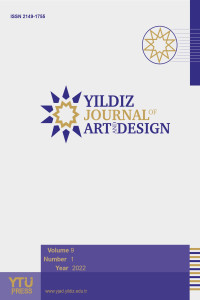SANATIN SONUNDAN SONRA: HER ŞEY SANAT, HERKES SANATÇI
“Sanatın Sonu” söylemleri sanat alanında artık pek rağbet görmemekte, çünkü son zamanlarda sonu gelebilecek ve dolayısıyla yeni bir anlatı dili geliştirilebilecek bir sanat alanından bahsetmek pek mümkün gözükmemektedir. Sanat tarihinde hem Duchamp hem de Warhol için bu söylemler sıkça dile getirilmiş ancak sanat alanına kendi dönemlerinde nefes aldıran bu iki isim, yaptıklarının farkında olarak ya da olmayarak bu söylemlere pek kulak asmamışlardır. Zaman içerisinde de ne kadar haklı oldukları, sanatın belli kalıplara sığmak gibi bir zorunluluğu olmadığı ve sanat algısının da değişebileceği gözler önüne serilmiştir. Sadece tek bir sorun vardır, o da değişen sanat algısı ve sanatçının yaptığı her şey sanattır anlayışı sonu gelmez bir tekrara düşecek ve içinden çıkılmaz bir hal almaya başlayacaktır. Bu çalışmada; Duchamp ve Warhol üzerinden yapılan sanat söylemlerinden yola çıkılarak “sanatın sonu” çanlarının süreç içerisinde neden çalamaz hale geldiği irdelenmektedir.
Anahtar Kelimeler:
Sanatın Sonu, Hazır –Nesne, POP-SANAT, DUCHAMP, ANDY WARHOL
AFTER THE END OF ART: EVERYTHING ART, EVERYONE ARTIST
The discourses about “the end of art” are not favored much anymore, because there is no definition of art that can be claimed to have come to an end recently. Over the course of art history these kind of arguments has been made on behalf of both Duchamp and Warhol, however those two names who created a fresh space at the art field in their times turned a deaf ear to these accusations intentionally or unintentionally. Eventually it has been proven that they were right about the fact that art doesn‟t have to follow the certain rules and the perception about art can be changed. İt is not easy to get used to this situation which is new and surprising for the art space, art market and art audience, as it is expected. These new movements, which can be called a breaking point, have revealed that what is different ant not art can also be art, and will eventually be accepted,and that the definition of artist will change radically. İn addition to the artist's effort for art, the idea of art gaining importance and the progress of this situation of parallel with the developing and changing world causedno discrimination in the process.The only one problem about this is that this new approach to art and the idea of everything the artist did is art would create a vicious circle and become an impasse. In this study, it is examined why the bells stopped tolling for the end of art in consideration of the statements made about art based on works of Duchamp and Warhol.
Keywords:
The End of Art, Ready-made, Pop-art, Duchamp, Andy Warhol,
___
- Baudrillard, J. (2012). Trans-Estetik, (Çeviren: Işık Ergüden). http://www.e-skop.com/skopbulten/cagdas-estetik-trans-estetik/996 [Erişim: 15 Mart 2018]
- Baudrillard, J. (2014). Sanat Komplosu/ Yeni Sanat Düzeni ve Çağdaş Estetik 1, çev: Elçin Gen –Işık Ergüden, İstanbul: İletişim.
- Baudrillard, J. (2016). Şeytana Satılan Ruh ya da Kötülüğün Egemenliği.(Editör: Oğuz Adanır). Baudrillard içinde İstanbul: Say Yayınları, 221-231.
- Danto, A. (2014). Sanatın Sonundan Sonra/ Çağdaş Sanat ve Tarihin Sınır Çizgisi, (Çeviren: Zeynep Demirsü). İstanbul: Ayrıntı.
- Dubuffet, J. (2010). Boğucu Kültür. (Çeviren:İsmet Birkan). Ankara: Dost Kitabevi Yayınları.
- Groys, B. (2017). Akışta/ İnternet Çağında Sanat. İstanbul: Koç Üniversitesi Yayınları.
- Kuspit, D. (2010). Sanatın Sonu, (Çeviren: Yasemin Tezgiden). İstanbul: Metis.
- Lazzarato, M. (2017). Marcel Duchamp ve İşin Reddi. (Çeviren: Sercan Çalcı). İstanbul: Kolektif Kitap
- Lotrınger, S. (2014). Sanat Korsanlığı. (J. Baudrillard). Sanat Komplosu/ Yeni Sanat Düzeni ve Çağdaş Estetik 1 içinde , (Çeviren: Elçin Gen – Işık Ergüden), İstanbul: İletişim, 9 -24.
- Warhol, A. (2016). Andy Warhol Felsefesi, (Çeviren: Elif Gökteke), İstanbul: Sel.
- Başlangıç: 2013
- Yayıncı: Yıldız Teknik Üniversitesi
Sayıdaki Diğer Makaleler
SANATIN SONUNDAN SONRA: HER ŞEY SANAT, HERKES SANATÇI
" Employing Photoshop in Producing Art Works from Raw Material and Consumed Waste
Mowafaq ALSAGGAR, Ala'a AL THENAT
COVİD-19 SALGINININ KÜLTÜR VE SANAT ORGANİZASYONLARINA ETKİSİ
